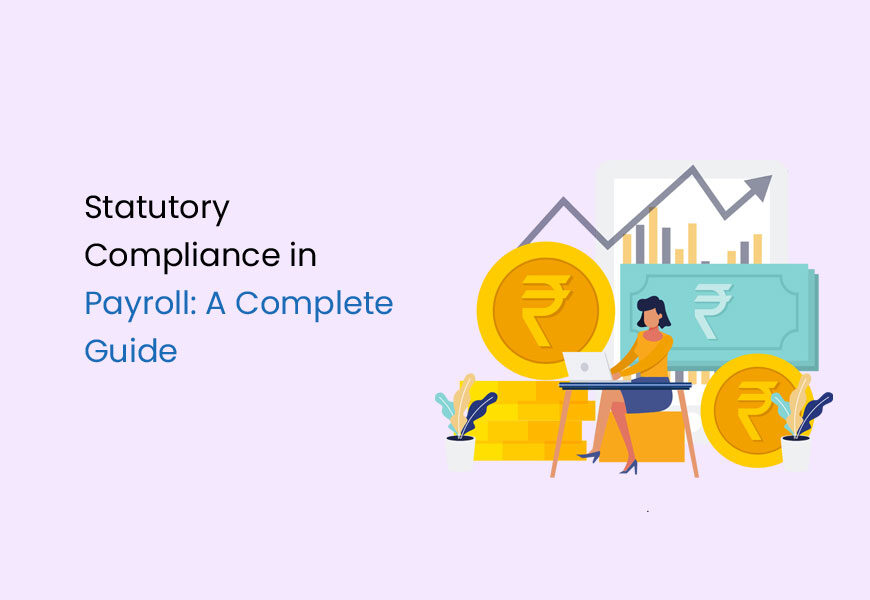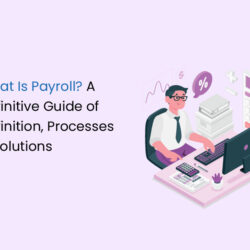India has a complex and ever-changing statutory compliance system when it comes to payroll including the processing of social security benefits, taxes and so on. There are labour laws and compliance frameworks of the state and central governments that employers need to follow, adding further to the complexity.
As an employer, it is crucial to stay up to date with the latest regulations and ensure you are compliant with all the relevant laws and regulations. Non-compliance attracts massive fines and penalties, legal troubles and damage to the employer’s reputation.
While statutory compliance in payroll is challenging enough for large corporations with all the resources, it can be particularly distressing for startups, small businesses, e-commerce businesses and so on. It can get even more challenging to keep pace with the statutes if you are employing informal workers such as temporary workers, gig workers and casual labourers. Here is a complete guide to help you ensure statutory compliance in payroll.
Why Is Statutory Compliance Important in Payroll?
Effective payroll management is critical, first and foremost, to ensure statutory compliance as non-compliance and even little slip-ups can attract hefty penalties and fines.
But its benefits don’t stop there; effective payroll management helps ensure greater levels of employee satisfaction. Employees get paid accurately and on time with proper payroll management and this has a direct impact on employee satisfaction and retention.
Properly managing the payroll enables employers to minimize the risks of errors of omissions and commissions, penalties, legal troubles and so on. Using automated tools such as the TankhaPay app also helps employers to save their time, administrative costs, efforts and resources significantly.
Effective payroll management also provides accurate financial reporting for employers, enabling effective budgeting and forecasting. It enables employers to accurately calculate their tax and other liabilities while managing the cash flow seamlessly.
How Statutory Compliance Benefits Both Employees and Employers?
Statutory Compliance Benefits For Employees
- Statutory compliance in payroll ensures that employees receive fair treatment within the organization.
- It assures employees of all genders equal access to opportunities and equal pay for equal work.
- It assures minimum wages to all employees in compliance with the applicable laws, with fair pay for work done.
- It guarantees good working conditions and workplace safety for all employees.
- It prevents exploitation of employees through long working, non-payment of wages, underpayment of wages, inhumane working conditions, etc.
- Statutory compliance in payroll also ensures employee health, safety and well-being.
- It guarantees the provision of social security benefits and compensation to employees which, in turn, creates a sense of financial security and independence.
Statutory Compliance Benefits For Employers
- Statutory compliance enables employers to prevent legal trouble, fines, non-compliance penalties and so on.
- Non-compliance also brings the risk of financial threats and losses which can be avoided through statutory compliance in payroll.
- Employers can prevent the risks of adverse work incidents at work that result in criminal liability, withdrawal of fiscal benefits, etc. through statutory compliance in payroll.
- It enables employers to prevent unreasonable and illegal wage hike demands and other demands from employees and labour unions.
- It helps bolster the employer’s reputation as fair and transparent and thereon, helps them to earn goodwill.
- Statutory compliance in payroll ensures better employee satisfaction, productivity and retention while enabling employers to attract a better pool of candidates. It also helps reduce absenteeism and attrition. Why so?
When employees are treated fairly, paid fair wages on time, provided social security and compensation in case of disablement or work accident, they will trust the employer more. They will be more productive owing to better health and working conditions ensured by social security benefits and other statutes.
Statutory Compliance Checklist in HR – 2023
- The Apprentices Act, 1961
- The Contract Labour Regulation and Abolition Act, 1970
- The Child Labour Regulation and Abolition Act, 1986
- The Industrial Disputes Act, 1946
- The Payment of Gratuity Act, 1972
- The Minimum Wages Act, 1948
- The Industrial Employment Standing Orders Act, 1946
- The Employees Provident Fund and Miscellaneous Provisions Act, 1952
- The Equal Remuneration Act, 1976
- The Employees State Insurance Act 1946
- The Payment of Bonus Act, 1965
- The Payment of Wages Act 1936
- The Factories Act, 1948
- The Employment Exchange(Compulsory Notification of Vacancies Act), 1959
- The Trade Unions Act, 1926
- The Workmen’s Compensation Act, 1923
- Inter-State Migrant Workmen (Regulation of Employment and Conditions of Service) Act, 1979
Statutory Compliance Rules and Regulations in India – 2023
Statutory compliance in payroll will differ based on the industry and type of business as each industry is governed by a number of labour laws and codes. In 2019, the Ministry of Labour and Employment tabled 4 bills in a bid to consolidate the 29 labour-related statutes of the Government of India. These bills are classified as
- Labour Wages
- Industrial Relations
- Social Security
- Occupational Safety, Health and Working Conditions
This comprehensive labour code also seeks to extend social security benefits to gig workers and informal workers moving forward.
Payment Of Wages Act, 1936
This Act ensures that all direct and indirect employees get paid on time and without any additional deductions apart from those mandated by the government. It mandates employers to pay wages to employees by the 7th of each month when there are 1000 or less employees and by the 10th of the month if there are more than 1000 employees.
The Act is applicable only to employees earning Rs.10,000 or less per month. It stipulates a maximum wage period of 1 month. The payment should be done by cash or cheque; bank transfers or other digital payment modes can be used only with the written consent of the employees. Non-payment, late payment of wages and other digressions attracts hefty fines and penalties.
Minimum Wages Act, 1948
This Act prevents the exploitation of employees by fixing a minimum that must be paid to the employee. This minimum wage is fixed by the state and central governments based on the profession, region and sector. It takes into account the prevailing cost of living and fixes the minimum wages each employee should get for the work they do. The wage period and job type are also considered in fixing the minimum wages.
Payment of Bonus Act, 1965
This Act seeks to incentivize employees through annual bonus payments. This is applicable to establishments and factories with 20 or more employees on any day during the financial year. To be eligible, employees must earn Rs. 21,000 or less monthly wages (basic + dearness allowance) and have completed 30 working days in that financial year.
Under the Act, an employer is required to pay a minimum bonus of 8.33% and maximum of 20% of the employee salaries and the profits earned by the organisation in that financial year. The bonus should be credited to the employee within 8 months of the closing of the accounting period.
Maternity Benefits Act, 1961 (Amended 2017)
This Act extends a range of maternity benefits for the welfare of women employees. Women employees are eligible for 26 weeks of paid maternity leave for upto 2 children. Maternity leave is only 12 weeks from the third child onwards. Women employees adopting a child below 3 months of age and commissioning mothers can avail upto 12 weeks of paid maternity leave.
To be eligible for these benefits, the employee must be working with the organisation for a minimum of 80 days within the past 12 months.
As per the Act, the employer can enable the work from home provision for women employees based on the nature of their work. Organisations with more than 50 employees must offer creche/ day care facilities for children.
The employer is required to reduce the employee’s workload 10 weeks before delivery. The employer cannot reduce the woman employee’s pay or terminate their employment during this period. Non-compliance can lead to the employer being imprisoned for a period of 3-12 months.
TDS or Tax Deducted from Source
This is one of the most important statutory compliances with respect to payroll. TDS seeks to collect taxes from individuals’ income at source. Based on the income of the employee, the rate of taxation and the amount of tax collected varies.
Under Section 192 of the Income Tax Act, the employer must deduct the relevant tax amount from the employee’s salary if it exceeds the basic exemption amount. They must submit the amount deducted to the government while the employee must file tax returns. If they are eligible as per the tax norms and slabs, they will get a tax refund.
ESI & EPF Deductions
The Employees’ State Insurance (ESI) scheme and the Employees’ Provident Fund (EPF) scheme are two important social security provisions that are mandated by the government. The ESI scheme is a government health insurance scheme and the EPF is a government retirement saving and insurance scheme.
Employees earning Rs. 21,000 or less (Rs.25000 or less in case of persons with disabilities) are covered under the ESI scheme. Employers must contribute 3.25% of the monthly wages of the employee while deducting 0.75% from the employee as their contribution.
Read more about ESI Calculation and Contribution Rate 2023
The sum total of both contributions must be deposited into the employee’s ESI account each month. By contributing to the scheme, employees gain cash-free access to comprehensive preventive and curative healthcare for themselves and their families. In addition, there is a host of cash and other benefits for employees and their dependents.
Employees earning Rs.15,000 or less working in organisations with 20 or more employees are eligible for the benefits of the EPF scheme. The employee must contribute 12% of their monthly wages while the employer contributes 13% (12% EPF+ EDLI+ Admin Charges). The sum total of contributions must be deposited into the employee’s EPF account every month.
Read more about EPF Contribution Rate: Calculate Contribution, Interest Rate
This scheme enables employees to save for retirement and create a reliable source of retirement income and a solid emergency corpus. In addition, the dependents of the insured employee are provided with monthly pensions and a lump-sum life insurance payment if the employee dies in service.
As per the provisions of the Act, these two schemes are not mandatory for informal workers. Further, households cannot extend these social security benefits to their household staff. With the TankhaPay app, all employers including individual households, small businesses and e-commerce platforms can extend comprehensive social security benefits to all employees including drivers, runners, peons, household workers and so on.
Payment of Gratuity Act, 1972
This Act applies to all establishments with 10 or more employees. It mandates employers to pay gratuity to their employees who have completed a minimum of 5 years of continuous service.
Gratuity is a lump sum amount to an employee as a form of gratitude for their services during their tenure of employment. The amount of gratuity payable to an employee is calculated based on the length of their service and their last drawn salary. The Act provides for payment of gratuity at the rate of 15 days’ wages for each completed year of service subject to maximum of ₹10 lakhs. Employers can also pay more than the Act’s maximum gratuity limit.
Labour Welfare Fund Act, 1965
This Act seeks to boost worker welfare through the provision of social security, improvement working conditions and bettering the standard of living of employees. The state labour welfare boards manage the fund and determine the frequency and amount of contribution to be made.
The money in the Labour Fund can be used to provide vocational training, housing facilities for workers, education for workers’ children, medical facilities for workers and their families and so on.
Payroll Management
Payroll is a term used to refer to a number of things. Most often, it is used to refer to the total number of employees that are entitled to wages and other benefits from an employer. Payroll also means the total amount of money paid to employees by the employer. Payroll is also used to refer to the process by which employees are paid – tracking their work hours, calculating pay and benefits, deducting taxes and distributing payments.
So, what is payroll management?
Payroll management is the process of managing and administering employees’ financial records. This includes tracking attendance and compensation including salaries, wages, bonuses, social security benefits and deductions. It involves ensuring that employees are paid accurately and on time, and that all relevant taxes and other deductions are calculated and deducted from their pay cheques.
Payroll management includes various tasks such as tracking attendance, calculating gross and net pay, processing and deducting taxes, generating pay cheques/ direct deposit payments, maintaining employee records, etc. It also involves complying with various statutory regulations related to payroll, such as minimum wage laws, overtime laws, tax laws and so on.
The Risk of Non-Compliance
Non-compliance to the requirements of the state and central labour laws have direct risks and consequences for the employer.
- Hefty penalties and fines for non-compliance
- Reputational damage
- Loss of brand value, integrity, customer trust and goodwill
- Legal and punitive action
- Lawsuits by disgruntled parties which could include trade unions, employees or government agencies.
- Unnecessary audits
So, How Are Wages Calculated in India?
The gross wage is inclusive of the basic wages, allowances, deductions, pay, commissions, bonuses, etc. This is typically the amount agreed upon in the terms of employment. From this amount, TDS and other deductions such as EPF, ESI, etc. are deducted. What remains will be the net wage that the employee will receive.
As per statutory compliance requirements, the employer must deposit all deductions (tax, EPF, ESI, labour fund, etc.) into appropriate schemes and accounts within the stipulated time period.
The Way Forward: How Can You Ensure Statutory Compliance for Your Organisation?
- Identity all applicable regulations and laws and understand the requirements.
- Document all policies & procedures.
- Stay updated on changing provisions of all relevant Acts and Policies.
- Conduct compliance audits to identify gaps in current processes and procedures.
- Continuously monitor compliance through reviews, assessments and internal audits.
- Train employees to help them understand their roles and responsibilities in ensuring statutory compliance.
Ensuring statutory compliance in payroll can be a challenging process, especially for smaller businesses and individual employers. One of the simplest and straightforward ways to ensure statutory compliance in payroll is through the TankhaPay app.





















